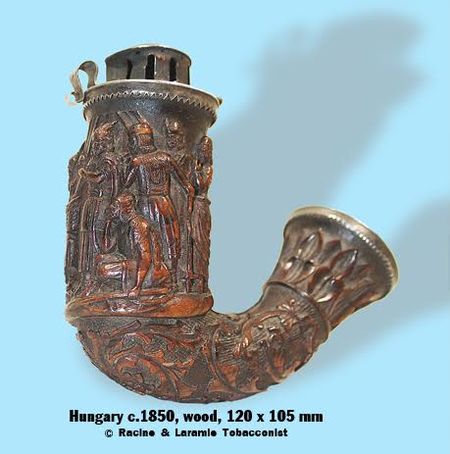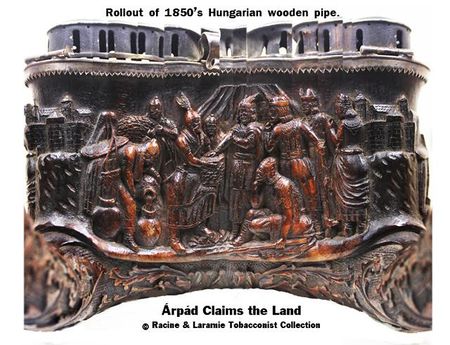Hungarian Kalmasche, 1850: Difference between revisions
(Created page with "'''''The following submission is courtesy of Geoffrey Mogilner of [http://www.racineandlaramie.com/ Racine & Laramie Tobacconist], who writes, "We thought that this particular...") |
No edit summary |
||
| Line 5: | Line 5: | ||
This wood pipe is carved with a scene of Árpád claiming the land. It is executed with minute attention to the details of the original lithograph by Geiger. The master craftsman was especially successful in the arrangement of the figures upon the cylindrical surface of the pipe head. The leaf ornamentation on the slender neck section is also delicate. Although the earliest of the graphic originals date from 1840s, this pipe was probably made in the late fifties and early sixties, when the Sunday periodical Vasárnapi Újság republished the prints. Our example’s cap is hallmarked with “Bartsch” and a Hungarian punch consisting of the Hungarian cross and number 13. Pure silver is 16 loth so 13 loth is .820 purity. | This wood pipe is carved with a scene of Árpád claiming the land. It is executed with minute attention to the details of the original lithograph by Geiger. The master craftsman was especially successful in the arrangement of the figures upon the cylindrical surface of the pipe head. The leaf ornamentation on the slender neck section is also delicate. Although the earliest of the graphic originals date from 1840s, this pipe was probably made in the late fifties and early sixties, when the Sunday periodical Vasárnapi Újság republished the prints. Our example’s cap is hallmarked with “Bartsch” and a Hungarian punch consisting of the Hungarian cross and number 13. Pure silver is 16 loth so 13 loth is .820 purity. | ||
<center><gallery widths=450px heights=500px caption"1850 Hungarian Kalmasche, courtesy Racine & Laramie Tobacconist"> | <center><gallery widths=450px heights=500px caption="1850 Hungarian Kalmasche, courtesy Racine & Laramie Tobacconist"> | ||
File:1850HungarianKalmasche.jpg | File:1850HungarianKalmasche.jpg | ||
File:1850HungarianKalmasche-Rollout.jpg | File:1850HungarianKalmasche-Rollout.jpg | ||
Revision as of 20:22, 23 December 2017
The following submission is courtesy of Geoffrey Mogilner of Racine & Laramie Tobacconist, who writes, "We thought that this particularly beautiful and historic pipe would be of interest to you." Thank you, Geoffrey! Indeed it is! --sethile (talk) 10:06, 23 December 2017 (CST)
After the crushing of the 1848-49 Hungarian bid for independence from the Habsburg Empire, media advocating separation from Austria was illegal. But, art featuring Hungarian history, the Conquest of the Carpathian Basin the princes Álmos and Árpád took on contemporary political significance. At a time when Hungary was being denied its sovereign rights, the pictures of Árpád claiming the land and of the contract between the settling Hungarian tribes sealed with blood from their chieftains collected in a bowl served as symbols of the freedom of the Hungarian nobility to choose their own kings as laid down in the constitution of hundreds of years tradition. It also demonstrated an attitude by the Hungarian nobility towards their history.
This wood pipe is carved with a scene of Árpád claiming the land. It is executed with minute attention to the details of the original lithograph by Geiger. The master craftsman was especially successful in the arrangement of the figures upon the cylindrical surface of the pipe head. The leaf ornamentation on the slender neck section is also delicate. Although the earliest of the graphic originals date from 1840s, this pipe was probably made in the late fifties and early sixties, when the Sunday periodical Vasárnapi Újság republished the prints. Our example’s cap is hallmarked with “Bartsch” and a Hungarian punch consisting of the Hungarian cross and number 13. Pure silver is 16 loth so 13 loth is .820 purity.
- 1850 Hungarian Kalmasche, courtesy Racine & Laramie Tobacconist

